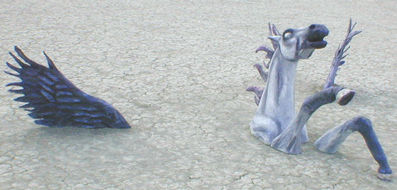Day One
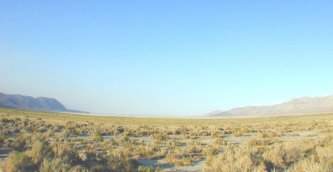 Driving down the last three miles onto the Playa of the Black Rock Desert is like entering a colossal clam shell. A big-sky lid of blue arches overhead and down to a seam of distant mountains which holds it to the endless horizontal of grayish-whitish desert. Within this space, on a spectacularly flat and ancient lake bed, Black Rock City —“home to Burning Man’s 30,000 soon-arriving citizens —“is sprouting from the lifeless ground. By Wednesday it will be in full flower, after Sunday’s close it will wilt, by next Tuesday the only trace of its existence will be tire tracks. Those making the journey to this ephemeral metropolis come to join in a celebration of music, dance, art, and round-the-clock creative mayhem in an environment where temperatures topping 120 degrees and white-out dust storms are the standard daily bill of fare. I’m here as Daily Chronicler for The Sultan’s Oasis, a theme camp of a dozen forty-something men led by Jack Haye and David Best, each in their own right accomplished artists in the world outside of Black Rock City.
Driving down the last three miles onto the Playa of the Black Rock Desert is like entering a colossal clam shell. A big-sky lid of blue arches overhead and down to a seam of distant mountains which holds it to the endless horizontal of grayish-whitish desert. Within this space, on a spectacularly flat and ancient lake bed, Black Rock City —“home to Burning Man’s 30,000 soon-arriving citizens —“is sprouting from the lifeless ground. By Wednesday it will be in full flower, after Sunday’s close it will wilt, by next Tuesday the only trace of its existence will be tire tracks. Those making the journey to this ephemeral metropolis come to join in a celebration of music, dance, art, and round-the-clock creative mayhem in an environment where temperatures topping 120 degrees and white-out dust storms are the standard daily bill of fare. I’m here as Daily Chronicler for The Sultan’s Oasis, a theme camp of a dozen forty-something men led by Jack Haye and David Best, each in their own right accomplished artists in the world outside of Black Rock City.
I’m also here because of my interest in the gift of creation —“the artist’s gift of inspiration and its reciprocation when the artist shares his creations with his community and the world at large. Black Rock City is a world apart, as creatively fertile as the ground is barren, a place out of reach of the commercial snares and entanglements of society’s market economy.
Black Rock City is a gift economy. Nothing is for sale here (after the $200 admission, only coffee and ice are sold at the Café). Corporate sponsors or media coverage with tabloid or blatantly commercial angles are banned. Barter is the only form of exchange, but mostly people share what they bring, be it art, food, drugs, or their ornately tattooed and absurdly decorated bodies.
One rule governs life at BM: no spectators allowed. The rule’s corollary is: no matter what you bring or don’t bring —“participate. Some artists spend an entire year planning an installation, then ceremonially cremate their work on Burning Man’s closing night. It’s all in the pleasure and passion of creating, giving and sharing. Team leader David Best is building a twenty foot high wooden pagoda-like sculpture on the Playa. Friday night he will douse it with kerosene and burn it.

“The Burning keeps the art in the land of the sacred,” says David when asked why he destroys something he could sell for tens of thousands of dollars when he returns to his home in Petaluma, California.
David is a compact man, deeply tanned, forever on the move. He has the penetrating blue-eyed gaze and an easy going manner that belies his creative intensity. When I met him for the first time three weeks ago, I knew immediately that whatever Burning Man was, if he was going I wanted to follow.
Right now, he’s out on the Playa, needing help with building his sculpture, and I’m out of time and past my word count limit for the day —¦
See more pictures from Burning Man 2000.
Day Two
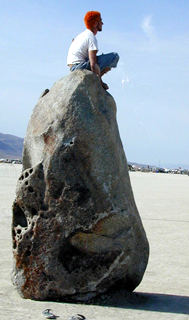
Gifts that remain gifts support an affluence of satisfaction. |
—“ Lewis Hyde, author |
Q: What’s the difference between Burning Man and a burning sailboat? A: Nothing. |
—“ David Best, artist |
Imagine Burning Man as a nine square mile art installation set on a thousand square miles of bleached alkaline desert. It’s a canvas only God could begin to fill.
Not everyone comes to Black Rock City to create, but those who do —“ limited only by means, talent, and ambition —“ create works of art ranging from body painting to mammoth sculptures. Every imaginable material is used —“fabric, wood, steel, the alkaline lake bed itself, a twenty-ton meteor-like boulder hauled from outside the nearby town of Gerlach, even light.
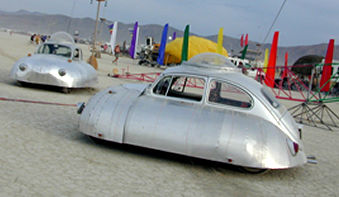 Patrick Flanagan has been in love with light as long as he can remember. With a riot of sandy hair, heart-and-star tattoos on his pecs, and coiled black earrings, it would be easy to mistake him for an aging Santa Cruz surfer-dude (he has homes there and in Sedona), not a scientist and inventor who spent a half-million dollars to bring a powerful krypton-argon laser to Burning Man.
Patrick Flanagan has been in love with light as long as he can remember. With a riot of sandy hair, heart-and-star tattoos on his pecs, and coiled black earrings, it would be easy to mistake him for an aging Santa Cruz surfer-dude (he has homes there and in Sedona), not a scientist and inventor who spent a half-million dollars to bring a powerful krypton-argon laser to Burning Man.
The hand-blown laser weighs eight-hundred pounds and requires a clean room environment and its own 6700-gallon water tanker to keep it cool. At work it is breathtaking. Despite only four hours sleep the previous night, I drag myself out to attend the show sometime late each night. (Time has no meaning here. It’s 24/7 here; the numbers on my watch no longer correlate with the quotidian.) To the pounding sound of techno-pop and bass-and-drum music, the laser sculpts an infinite variety of half-mile long, three-dimensional geometrical objects over and around us, then spins them into the sky. It is awe-inspiring. Despite the siren call of my sleeping bag I laugh and dance within the light until the show ends some hours(?) later.
I asked Patrick why he does it. Why spend so much money and time to come to Burning Man? He doesn’t know. Instead he talks about the Sacred Ratio in the works of Rembrandt and DaVinci. The laser uses an algorithm based on the ratio, which also determines the placement of leaves on trees and the proportions of the human body. When he finishes I ask again: why the money, why the time? He thinks a minute.
“In the outside world, time is money,” he says at last. “At Burning Man, time is art.”
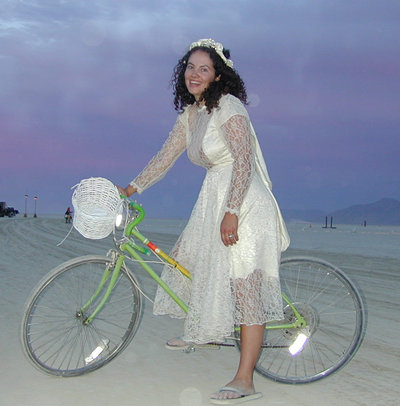
See more pictures from Burning Man 2000.
Day Four
Some days the Playa has the final word. After nearly a week, construction is all but finished on David Best’s sculpture, referred to as “the build” or The Temple, and it’s time to paint. There’s only seven gallons of paint, however, to cover a structure thirty feet square and twenty feet high, and David decides to paint only the interior and the rooftop spire. The resulting contrast of bare wood and dark pinkish interior walls and altar is stunning, a tribute to a man who sees new possibilities for expression in a shortfall of material where most of us would only see a problem.
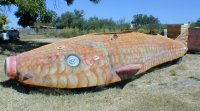 An hour later in the early evening, the paint still drying, a boiling dust storm rolls across the Playa from the northeast. Visibility drops to six feet and The Temple disappears. Returning in the storm’s aftermath, a half-inch of fine Grey Playa-dust has aged the interior a thousand years. Entering, one feels like one has stumbled onto some ancient temple.
An hour later in the early evening, the paint still drying, a boiling dust storm rolls across the Playa from the northeast. Visibility drops to six feet and The Temple disappears. Returning in the storm’s aftermath, a half-inch of fine Grey Playa-dust has aged the interior a thousand years. Entering, one feels like one has stumbled onto some ancient temple.
A crowd soon gathers to take pictures, ooh and ahh. David mingles easily with the crowd, answering questions with straight-faced good humor —“yes, a man cut all these pieces by hand; no I work for Steven Spielberg; he’s going to have this helicoptered out. Then in all seriousness, he goes into the crowd to ask a favor: if any of them have lost someone close to them recently, would they please write his or her name on a piece of paper, roll and tie it up, and put it on the altar before Friday midnight, the fiery end of the temple’s one day existence.
David is an artist who requires some sort of catalyst, a gift, with which to create. Three weeks ago, Michael Hefflin —“ actor, sword fabricator, cycle enthusiast, and David’s friend —“ who at 33 would have been the youngest member of our camp, was killed in a motorcycle accident. Though The Temple has been in the planning stages for a half-year, Michael’s spirit is what David puts into the work.
“Michael’s death was a waste,” said David. “But we won’t waste our love for him. People won’t see it when they walk by, but it’ll be there nonetheless.” He may be wrong though. In addition to being beautiful and imbued with the creative spirit, the dark interior has the unmistakeable feel of somber tribute.
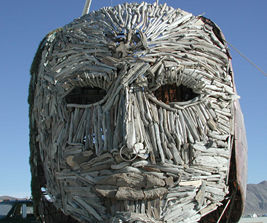
See more pictures from Burning Man 2000.
Final Day
Black Rock City, Friday.
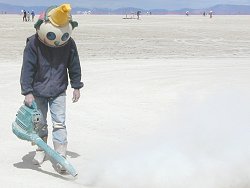 Rising from the ash-gray dust of the Playa like the phoenix, David Best’s “Temple of the Mind” will live for little more than a day before returning to dust and ash.
Rising from the ash-gray dust of the Playa like the phoenix, David Best’s “Temple of the Mind” will live for little more than a day before returning to dust and ash.
The physical labor has stopped. The structure is done, but David is not. For parts of the day Friday, and continuously through Friday evening, he lives on or near the site, retelling the story of the temple’s genesis and Michael Hefflin’s death to all who will listen. As David’s close friend, Jack Haye, says, “David can’t help but be creative.” With physical work complete, David is now busy filling his work with spirit and feeling. Through his stories and the force of his personality, people are induced to leave names, words, and other offerings on the temple’s altar. By dusk, the structure becomes a shrine to the memories and feelings for those we have loved and lost. David puts a lighter spin on the work, consoling us to “[at midnight] think of all our friends rising up in flames together.”
I myself return throughout the day to the temple-partly to savor its beauty and partly to compare others’ reactions with mine. Mine are strong and visceral, but I question whether they are in response to the work itself or are in some part a sentimental reaction based on my involvement with the project. Of the dozens of works on the Playa, only one other has moved me as much: the copper-sheathed woman’s face on the Promenade that at night weeps tears of fire.
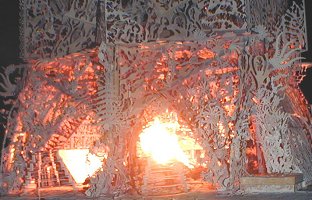 Within the temple’s brownish-purple interior, there is the hushed and reverential feeling of a sanctuary. Some people gasp or exclaim when they enter while others glance around and leave. Of those who linger, some sit in contemplation on benches along the walls; others stand by the altar reading the messages and names left there, at the center of which hangs a photograph of Michael Hefflin.
Within the temple’s brownish-purple interior, there is the hushed and reverential feeling of a sanctuary. Some people gasp or exclaim when they enter while others glance around and leave. Of those who linger, some sit in contemplation on benches along the walls; others stand by the altar reading the messages and names left there, at the center of which hangs a photograph of Michael Hefflin.
On paper and on blocks of wood scattered underneath the altar, people use pencils, pens-even burnt match heads-to write messages, prayers and poems to lost friends and family. Even some of those who come only to observe leave the temple wiping tears from their eyes (putting to rest my doubts concerning the source of my own feelings).
In the evening, I listen to David address groups of people in and around the temple with the story, now embellished with his reflections on his experience of building the temple.
“As I was helping build the structure, people kept asking me if I was the artist,” says David with a pause. “After a while I realized that it was no longer my piece but belonged to you, the community of Burning Man, and I was the church carpenter working on a new building for the congregation.”
A woman stands by the entrance silently weeping. David approaches and greets her.
“It’s so beautiful,” she says and brings her hands to her face. She whispers something I cannot hear. David puts an arm around her. “Would you come outside with me please,” he says gently. “I’d like to talk to you.” As they walk away, I cannot help but think that his final role in the life of this work is that of temple priest
The evening Playa sky is thick with fast-moving, dark clouds. Night falls quickly. I set up two flood lights and a generator by the temple’s entrance. Word of the structure has spread throughout Black Rock City, and a continuous crowd of fresh faces circulates past the altar; flowers, photographs, oranges, and other mementos now share the altar with Michael’s picture.
At eleven o’clock, several volunteer firemen arrive and final preparations begin. We clear the area of spectators and bring two cans of diesel fuel and twenty small bottles of gasoline to the site.
With the grand finale burning of the Man not taking place until Saturday night, ours is the main pyrotechnic event on the Playa. A cheery crowd of several thousand has gathered around the perimeter. By midnight, however, no one has located the ladder needed to place the gasoline in the structure’s upper levels and the crowd grows impatient. Their chants of “Burn it! Burn it! Burn it!” have at times a menacing tone that adds to the anxiety of those locked within the circular wall of bodies.
 At last, a ladder is found; the bottles are placed. David has asked a young man who lost his wife three months ago to light the fire. The man tries to speak to the crowd, but his words are drowned out by the rising clamor for fire. He shouts a few words and enters the temple to light the pyre.
At last, a ladder is found; the bottles are placed. David has asked a young man who lost his wife three months ago to light the fire. The man tries to speak to the crowd, but his words are drowned out by the rising clamor for fire. He shouts a few words and enters the temple to light the pyre.
The wind is not favorable, and despite ten gallons of diesel fuel, the fire sputters. A member of our camp, Patrick, risks third-degree burns or worse to dash in the back side of the structure and set a second fire. It too sputters.
Suddenly the wind changes to the east and flames leap through the structure’s ceiling, igniting several bottles of gasoline. Within fifteen seconds, half the structure is ablaze; the temperature gets so hot that I cannot face the fire for more than a second or two. Those of us on the line closest to the fire cannot get away fast enough, but the crowd impedes our escape. The retreat of the crowd is slowed by their large numbers and the dozens of bicycle booby-traps laid helter-skelter on the ground.
In minutes, the temple is completely ablaze. As planned, preplaced pyrotechnics erupt from the roof of the temple, but then a box of fireworks on the ground too close to the temple spontaneously ignite, shooting exploding balls into the sky and into the crowd, miraculously injuring none. The walls soon collapse inward, drawing a cheer from the fire-hyped crowd-then a cold rain begins. As the fire loses intensity, the crowd presses back towards the heat of the blaze. I gather up the smoking floodlights and an empty jerry can of diesel and head back to camp for a celebratory margarita and some much-needed sleep.
Waking to a clear, cold Saturday morning, the remnants of the temple are still burning, kept alive by a small group of all-night revelers. We break camp, and by mid-afternoon, we have erased all traces of the temple from the Playa. Our camp plans to watch the burning of the Man that night and leave Sunday at daybreak. But I’m sated; as participant, witness, and chronicler I have what I came for —“not just a taste, but a banquet, a groaning board of the artistic delights and dares of Burning Man. As darkness falls, I say my good-byes and leave Black Rock City, wondering how I can apply the freedom and generosity of creative spirit of Burning Man to my own work. There is no shortage of ideas. One of them involves returning to the Black Rock Desert and Burning Man next year.
